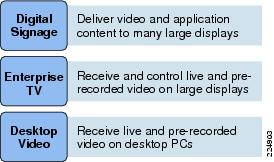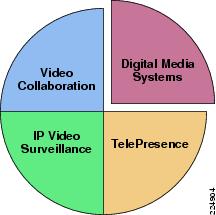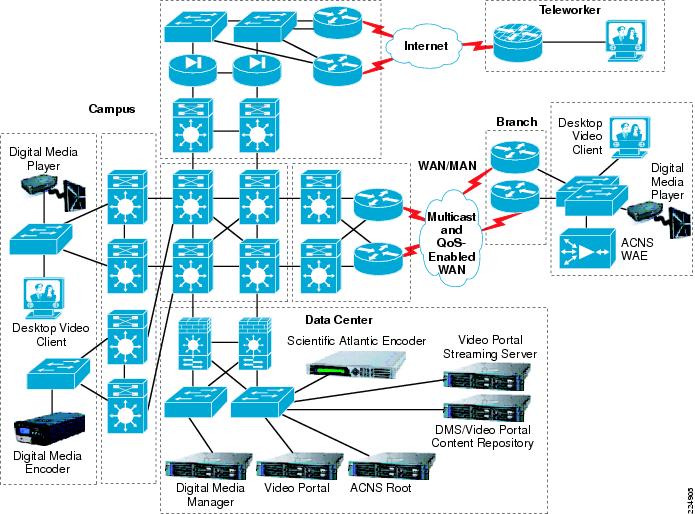Table Of Contents
Design Considerations for Digital Media Systems Over a PIN Architecture
Benefits of Using Cisco Digital Media Systems
PIN Architecture Design Considerations
Campus PIN Design Considerations
Branch PIN Design Considerations
Design Considerations for Digital Media Systems Over a PIN Architecture
DMS Overview
The Cisco Digital Media System (DMS) is a comprehensive suite of Digital Signage, Enterprise TV, and Desktop Video (see Figure 1) applications that allows companies to use digital media to increase sales, enhance customer experience, and facilitate learning.
Figure 1 DMS components
Benefits of Using Cisco Digital Media Systems
Today, digital media is the most compelling platform to effectively reach customers, employees, partners, and students with important information, news, training, and events.
Digital Signage
Digital signage provides scalable, centralized management and publishing of high-quality content to networked, on-premise digital signage displays.
Enterprise TV
Enterprise TV allows organizations to deliver live and prerecorded content, controlled by the end user. Content could include news, financial information, sales and marketing, learning/training, corporate communications, and entertainment video.
Desktop Video
Desktop video offers customers, employees, partners, and students access to high-quality and compelling videos-on-demand (VoDs) and live Webcasts at their desktops. Digital media can be browsed, searched, and viewed over the network through a unique, easy-to-use Cisco video portal experience—anywhere, anytime.
DMS Network Requirements
Bandwidth
Bandwidth requirements vary greatly with DMS, anywhere from 200Kbps to 15Mbps. Digital Signage and Enterprise TV require 1.5 to 5Mbps for standard definition streaming video content and 8 to 15Mbps for high-definition streaming content. Desktop video generally requires 200Kbps to 1.5Mbps for live streaming video content.
Non-live content, VoDs, will have similar bandwidth requirements when streamed across the network. Remote locations may take advantage of ACNS and WAAS for content prepositioning and caching to reduce bandwidth requirements for VoDs. ACNS and WAAS may also be used to perform stream splitting on live streams for desktop video.
Latency and Jitter
For live streaming video, latency and jitter requirements are not extremely stringent. As long as enough bandwidth exists to service all requests, even large amounts of latency and jitter will not impact video quality. For prerecorded content some latency and jitter requirements are provided when using TCP as the transport. More specific requirements are shown in Table 1.
Packet Loss
For live streaming content, lost packets are not retransmitted and with the amount of compression used by the video codecs, even a single packet lost will result in degradation of video quality. Avoiding any packet loss is the highest priority for live streaming video. Packet loss above 0.001% will be noticeable in H.264 streams and considered unacceptable over an extended period of time.
Figure 2 Digital Media Systems
Application Network Services
Cisco ACNS
ACNS may be used to preposition VoD content for all three DMS subsystems. Benefits provided by ACNS include the following:
•
Reducing demand on the WAN during peak hours
•
Allowing multiple branch clients to access content only transferred across the WAN once
•
Ensuring quality of content by accessing locally
ACNS may be used with desktop video live-streaming content performing stream transport and splitting. This reduces bandwidth requirements on the WAN by sending a single stream to a remote location, regardless of the number of clients at that location. ACNS may also be used to convert unicast to multicast for desktop video, delivering multicast to remote location.
Cisco WAAS
With the introduction of WAAS 4.1, Video Portal implementations now benefit from additional stream splitting and content optimization capabilities in WAAS. All three sub-systems of DMS support the use of CIFS for content access allowing additional content prepositioning and caching using CIFS shares in WAAS.
Performance Routing
Performance Routing (PfR), an optimization technology, can be used to ensure DMS video content takes the optimal path through the WAN.
PIN Architecture Design Considerations
Campus PIN Design Considerations
Within the campus, one of the primary design considerations is multicast enablement. Live video content delivery with digital signage and Enterprise TV requires multicast. The Digital Media Player supports IGMP v3 and the use of source specific multicast (SSM) is recommended, if possible.
Within the campus, use of technologies to segment or virtualize the network may be implemented, such as VRF-Lite to segment some or all video content if desired.
Branch PIN Design Considerations
Branch locations may be designed with a single WAN connection or multiple WAN connections. Multiple connections combined with redundant Integrated Services Routers (ISRs) give the highest availability. Dual links and ISRs also enable the use of additional optimization services such as PfR.
WAN PIN Design Considerations
DMS services available to branch locations are dependent on the WAN type. A high-speed multicast enabled WAN is required for live video delivery to digital signage and Enterprise TV. Live video deliver to desktop video clients does not have this requirement and may be implemented over a lower speed non-multicast WAN.
Enabling QoS on the WAN is essential for any critical content being delivered. Within DMS, live streaming content relies on a QoS-enabled WAN for guaranteed delivery meeting specific requirements for latency, jitter, and especially loss.
Summary
The medianet enables DMS, a powerful collection of video- centric tools, to benefit both internal and customer-facing aspects of business. More information is available at the following URL:
http://www.cisco.com/go/designzone.
Figure 3 DMS Architecture


